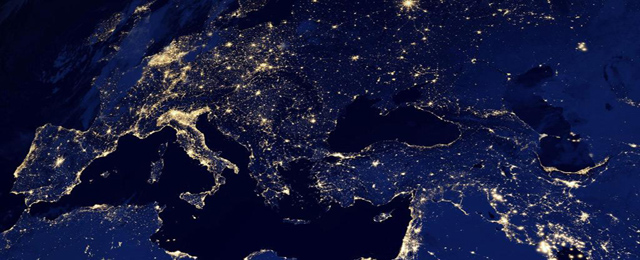It is very interesting to look at photos of Europe, taken at night via satellite. White, shiny splotches clearly indicate the most developed areas – the Benelux countries, the Paris area, the Ruhr region and the Rhine Valley. The Po River plain sparkles too as do Rome, its suburbs and the Gulf of Naples.
Great Britain, Madrid, Barcelona and the Portuguese coast are bathed in light. In central Europe, the brightest spot is Silesia. Prague can be seen as well as Budapest, Warsaw and Gdansk. Athens and Belgrade also shimmer. A belt of light lines the Bosporus and fabulous Istanbul. In Romania, Bucharest – the most lit up zone – is linked to Ploieşti [56km north] and further away, a pale line cuts through the Carpathian Mountains all the way to Braşov. Further east, there are a few white dots (Kiev, Minsk) all the way to Moscow, which is an island of white lost in the vastness of Russia.
The EU Parliament has decided to make this photo the poster for the elections, scheduled for next spring, with the slogan “Act. React. Impact.” A picture is worth a thousand words.
Europe’s glow dims
On the photo, hundreds of thousands of light spots trace the outline of the EU which is much more lit up, on the whole, than are eastern Europe or North Africa. Despite its problems the EU remains a better place than many others on Earth or so seem to imply those who designed the poster. Yet, upon closer inspection, the European glow tends to dim a bit.
The euro crisis, austerity – and its inherent social problems – as well as questions on the durability of the European social model have weakened the credibility of all European institutions. In fact, they question the credibility of the European project as a whole.
According to the latest Eurobarometer published in July 2013, the number of Europeans who no longer trust the EU is higher than 60 per cent. That is double what it was in 2007, before the crisis began. In the June 2009 EU elections, the participation rate was barely over 43 per cent, much lower than the 60 to 70 per cent participation rate in national elections current in advanced democracies. Although the EU Parliament’s powers were reinforced under the provisions of the Lisbon Treaty, a lower participation rate than the one in 2009 would seriously question its legitimacy.
For the first time, EU citizens will have the opportunity to vote for a parliament which will have the chance to vote on who becomes the next EU Commission President for the next five years. The EU Council will propose a candidate for the post, in accordance with the results of the EU Parliamentary elections. Candidates for the EU presidency will thus have to seek support within member states, as do local politicians during national elections. This should stimulate debate and make citizens better aware of European issues.
*Read the full article here.






Be the first to comment on "European Elections 2014: Shining Bright Under a Dark Sky"